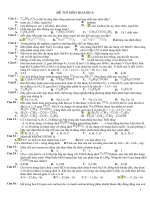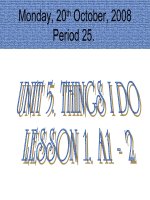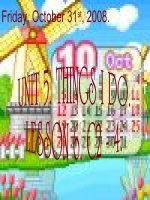Models you can count on grade 6
Bạn đang xem bản rút gọn của tài liệu. Xem và tải ngay bản đầy đủ của tài liệu tại đây (3.35 MB, 80 trang )
Models You
Can Count On
Number
Mathematics in Context is a comprehensive curriculum for the middle grades.
It was developed in 1991 through 1997 in collaboration with the Wisconsin Center
for Education Research, School of Education, University of Wisconsin-Madison and
the Freudenthal Institute at the University of Utrecht, The Netherlands, with the
support of the National Science Foundation Grant No. 9054928.
This unit is a new unit prepared as a part of the revision of the curriculum carried
out in 2003 through 2005, with the support of the National Science Foundation
Grant No. ESI 0137414.
National Science Foundation
Opinions expressed are those of the authors
and not necessarily those of the Foundation.
Abels, M., Wijers, M., Pligge, M., and Hedges, T. (2006). Models You Can Count On.
In Wisconsin Center for Education Research & Freudenthal Institute (Eds.),
Mathematics in Context. Chicago: Encyclopædia Britannica, Inc.
Copyright © 2006 Encyclopædia Britannica, Inc.
All rights reserved.
Printed in the United States of America.
This work is protected under current U.S. copyright laws, and the performance,
display, and other applicable uses of it are governed by those laws. Any uses not
in conformity with the U.S. copyright statute are prohibited without our express
written permission, including but not limited to duplication, adaptation, and
transmission by television or other devices or processes. For more information
regarding a license, write Encyclopædia Britannica, Inc., 331 North LaSalle Street,
Chicago, Illinois 60610.
ISBN 0-03-038578-4
1 2 3 4 5 6 073 09 08 07 06 05
The Mathematics in Context Development Team
Development 2003–2005
Models You Can Count On was developed by Mieke Abels and Monica Wijers.
It was adapted for use in American schools by Margaret A. Pligge and Teri Hedges.
Wisconsin Center for Education
Freudenthal Institute Staff
Research Staff
Thomas A. Romberg
David C. Webb
Jan de Lange
Truus Dekker
Director
Coordinator
Director
Coordinator
Gail Burrill
Margaret A. Pligge
Mieke Abels
Monica Wijers
Editorial Coordinator
Editorial Coordinator
Content Coordinator
Content Coordinator
Margaret R. Meyer
Anne Park
Bryna Rappaport
Kathleen A. Steele
Ana C. Stephens
Candace Ulmer
Jill Vettrus
Arthur Bakker
Peter Boon
Els Feijs
Dédé de Haan
Martin Kindt
Nathalie Kuijpers
Huub Nilwik
Sonia Palha
Nanda Querelle
Martin van Reeuwijk
Project Staff
Sarah Ailts
Beth R. Cole
Erin Hazlett
Teri Hedges
Karen Hoiberg
Carrie Johnson
Jean Krusi
Elaine McGrath
(c) 2006 Encyclopædia Britannica, Inc. Mathematics in Context
and the Mathematics in Context Logo are registered trademarks
of Encyclopædia Britannica, Inc.
Cover photo credits: (left to right) © Comstock Images; © Corbis;
© Getty Images
Illustrations
1, 3, 8, 12, 13, 16, 18, 19, 26 Christine McCabe/ © Encyclopædia Britannica,
Inc.; 28 Holly Cooper-Olds; 29 (top) Christine McCabe/ © Encyclopædia
Britannica, Inc. (bottom) Holly Cooper-Olds; 30, 34, 35 Holly Cooper-Olds;
37 (bottom) Christine McCabe/ © Encyclopædia Britannica, Inc.; 40
© Encyclopædia Britannica, Inc.; 45, 46, 49, 52, 55, 56, 60, Christine
McCabe/© Encyclopædia Britannica, Inc.
Photographs
1–5, 7, 11 Victoria Smith/HRW; 20 Don Couch/HRW Photo; 23 Sam
Dudgeon/HRW Photo; 27 © Corbis; 42 © Paul A. Souders/Corbis;
43 © Corbis; 44 Image 100/Alamy; 46 PhotoDisc/Getty Images; 47
(top) Photo courtesy of the State Historical Society of Iowa, Des Moines;
(bottom) ©SSPL / The Image Works; 50 Sam Dudgeon/HRW; 51 © Index
Stock; 54 Mike Powell/Getty Images
Contents
Letter to the Student
Section A
The Ratio Table
Recipe
School Supplies
Recipe
Summary
Check Your Work
Section B
26
27
28
29
31
34
36
37
The Double Number Line
Double Scale Line
City Blocks
Weights and Prices
Summary
Check Your Work
Section E
13
15
18
20
22
23
The Number Line
Distances
Biking Trail
Signposts
Map of Henson Creek Trail
The Jump Jump Game
Guess the Price
Summary
Check Your Work
Section D
1
2
8
10
11
The Bar Model
School Garden
Water Tanks
Percents on the Computer
A Final Tip
Summary
Check Your Work
Section C
vi
40
42
44
48
49
Double Scale
Choose Your Model
School Camp
Meter Spotting
Summary
Check Your Work
50
52
58
59
Additional Practice
61
Answers to Check Your Work
66
Contents v
Dear Student,
Welcome to the unit Models You Can Count On.
Math students today can no longer be comfortable merely doing
pencil and paper computations. Advances in technology make it more
important for you to do more than perform accurate computations.
Today, it is important for you to make sense of number operations. You
need to be able solve problems with the use of a calculator, confident
that your result is accurate. When shopping in a store, you need to be
able to estimate on the spot to make sure you are getting the best
deal and that the cash register is working properly.
In this unit, you will look at different number models to help you
improve your understanding of how numbers work. You will examine
various recipes that could be used to feed large groups of people. You
will consider how students can share garden plots. You will observe
computer screens during a program installation. You will make sense
of signs along a highway or bike trail. In each situation, a special model
will help you make sense of the situation. You will learn to use these
models and count on them to solve any problem!
We hope you enjoy this unit.
Sincerely,
The Mathematics in Context Development Team
vi Models You Can Count On
A
The Ratio Table
Recipe
Today, both men and women prepare food in the
kitchen. Have you ever worked in the kitchen? Think
about your favorite recipe.
1. Make a list of the ingredients you need for this
recipe. What else do you need to prepare your
recipe?
Ms. Freeman wants to make a treat for her class.
This is her favorite recipe. It makes 50 Cheese Puffles.
Cheese Puffles (makes 50)
Ingredients: 2 cups wheat flour
1 cup unsalted butter
2 cups grated cheese
4 cups rice cereal
Directions:
Preheat the oven to 400°F. Cream the flour, butter,
and cheese together in a large bowl. Add rice
cereal and mix into a dough. Shape Puffles into
small balls, using your hands. Bake until golden,
about 10-15 minutes. Let cool.
There are 25 students in Ms. Freeman’s class.
2. a. How many Cheese Puffles will each student get if
Ms. Freeman uses the amounts in the recipe?
b. If she wants each student to have four Cheese Puffles, how
can you find out how much of each ingredient she needs?
Ms. Freeman invites her colleague, Ms. Anderson, to help her make
the Cheese Puffles. They decide to make enough Puffles to treat the
entire sixth grade. There are four sixth-grade classes with about 25
students in each class.
3. How much of each ingredient should they use? Explain.
Section A: The Ratio Table 1
A The Ratio Table
School Supplies
Jason manages the school store at Springfield Middle
School. Students and teachers often purchase various
school items from this store.
One of Jason’s responsibilities is to order additional
supplies from the Office Supply Store.
Today Jason has to make an order sheet and calculate
the costs.
Use Student Activity Sheet 1 to record your answers
to questions 4–6.
Item
Cost
6 boxes of rulers
$_____
25 packs of notebooks
$_____
9 boxes of protractors
$_____
5 boxes of red pens
$_____
8 boxes of blue pens
$_____
Total Cost
$_____
Jason starts with 6 boxes of rulers. He uses a previous bill to find the
cost. The last bill shows:
3 boxes of rulers
$150
4. Find the price for 6 boxes of rulers. Explain how you found the
price.
Jason's last order was for 10 packs of notebooks.
10 packs of notebooks
$124
5. Calculate the price for 25 packs of notebooks. Show your
calculations.
2 Models You Can Count On
The Ratio Table A
Here is the rest of the bill.
10 boxes of protractors
$420
20 boxes of red pens
$240
10 boxes of blue pens
$120
6. a. Use the information from this bill to calculate the price for nine
boxes of protractors. Show your work.
10 boxes of
protractors
$420
9 boxes of
protractors
$ ...?
b. Complete the order sheet on Student Activity Sheet 1.
Jason uses a ratio table to make calculations
like the ones in the previous problems. Here
is his reasoning and work.
“I know that the price of 20 boxes of red pens is
$240. I use this information to set up the labels
and the first column of the ratio table.
Now I can calculate the price of five
boxes of red pens.”
Number of Boxes of Red Pens
20
10
5
Price (in Dollars)
240
120
60
Section A: The Ratio Table 3
A The Ratio Table
7. a. Explain how Jason found the numbers in the second and third
columns.
b. Use the information in Jason’s ratio table to calculate the price
of 15 boxes of red pens. Explain how you found your price.
c. Use the ratio table below to calculate the price for 29 boxes
of red pens. (You may add more columns if you need them.)
Explain how you found the numbers in your columns.
Number of Boxes of Red Pens
20
Price (in dollars)
240
When using a ratio table, there are many different operations you can
use to make the new columns.
8. Name some operations you can use to make new columns in a
ratio table. You may want to look back to problem 7.
Packages shipped to the school store contain different
amounts of items; for example, one box of protractors
contains one dozen protractors.
9. Use Student Activity Sheet 2 to find the number of protractors
in 8, 5, and 9 boxes.
a. 8 boxes:
Number of Boxes
1
Number of Protractors
12
2
4
8
How did you find the number of protractors in the last column?
b. 5 boxes:
Number of Boxes
1
Number of Protractors
12
10
5
How did you find the number of protractors in the last column?
c. 9 boxes:
Number of Boxes
1
Number of Protractors
12
10
9
How did you find the number of protractors in the last column?
4 Models You Can Count On
The Ratio Table A
10. Jason ordered a supply of 132 protractors. How many boxes will be
shipped? You can use the ratio table on Student Activity Sheet 2.
Number of Boxes
1
Number of Protractors
12
A math teacher at Springfield Middle School would like to have
calculators for her class. The school store offers calculators for $7
each. She asked her sixth-grade students to calculate the total price
for 32 calculators. Here are strategies from three of her students.
Romero
Number of Calculators
1
2
4
8
16
32
Price (in dollars)
7
14
28
56
112
224
11. Describe the steps Romero used.
Cindy
Oops!!
Number of Calculators
1
10
30
32
Price (in dollars)
7
70
210
212
Cindy did something wrong when she filled in the last column.
12. a. Explain how Cindy found the numbers in the last column.
Explain why this is not correct.
b. What should the numbers in the last column be?
Sondra
Number of Calculators
1
10
20
30
2
32
Price (in dollars)
7
70
140
210
14
224
13. Describe the steps Sondra used for her ratio table.
Section A: The Ratio Table 5
A The Ratio Table
A ratio table is a convenient tool you can use to solve problems. You
start with two numbers that are related to each other as a ratio. Then
you can use an operation to create a column with new numbers in the
table so that they have the same ratio. Using arrows, you can keep
track of the operations you used.
Here are operations you can use.
Halving or Dividing by Two
Doubling or Multiplying by Two
؋2
،2
؋2
packages
1
2
4
crates
pencils
15
30
60
crayons
؋2
،2
8
4
2
1
480
240
120
60
،2
؋2
Times Ten
،2
،2
،2
Multiplying
؋ 10
؋2
؋5
packages
1
10
packages
1
2
10
pencils
15
150
pens
15
30
150
؋ 10
؋2
؋5
Dividing
،5
، 100
crates
500
5
1
markers
2000
20
4
،5
، 100
For the two operations below, you would choose two columns in the
ratio table and add them together or find the difference.
Subtracting Columns
Adding Columns
؋2
؋ 10
؉ column 1
؊ column 1
packages
1
2
3
packages
1
10
9
pencils
15
30
45
pencils
15
150
135
؋2
6 Models You Can Count On
؉ column 1
؋ 10
؊ column 1
The Ratio Table A
You can use more than one operation in one ratio
table. For example, here is Walter’s solution for the
problem “How many pencils are in 90 packages?”
Walter
Packages
1
2
4
8
9
90
Pencils
15
30
60
120
135
1,350
14. What operations did Walter use? How will he answer the
question?
The Office Supply Store where Jason buys the supplies for the school
store displays a poster of some products sold.
Office Supply Store
Item
Number in Box
Price per Box
Bottle of Glue
5
$6.25
Calculator
4
$26
Notebook, lined
10
$17.50
Pen: blue, black, or red
48
$12
Gel Pen
20
$7
Pencil with eraser
15
$2.25
Protractor
12
$42
Ruler (30 cm)
25
$50
Tape
8
$7.20
Notes
Special offer:
$1.50 per box
Jason ordered 720 pens and received 15 boxes. He wants to know
how many pens are in each box. He sets up the following ratio table.
Boxes
15
……
……
Pens
720
……
……
15. How many pens are in one box? You may copy and use Jason’s
ratio table to find the answer.
Section A: The Ratio Table 7
A The Ratio Table
Number of Gel Pens
20
10
1
Price (in dollars)
7
3.50
0.35
For the school store Jason wants to create notes for single-priced
items. He uses a ratio table to calculate the price for one gel pen.
16. a. What operations did Jason use in his ratio table?
b. Ahmed buys 3 gel pens. How much does he have to pay for
them?
Ms. Anderson wants all of her students in sixth grade to have a lined
notebook. She buys the notebooks from the school store and sells
them to her students. There are 23 students in her class.
17. Create and use a ratio table to calculate how much Ms. Anderson
has to pay for 23 lined notebooks.
Recipe
Play Dough (1 portion)
Ingredients: 2 1᎑᎑
2 cups flour
1᎑᎑ cup salt
2
1 tablespoon
powdered alum
Directions:
2 cups water
2 tablespoons salad oil
food coloring
In a large bowl, mix flour, salt, and alum together;
set aside.
In a medium saucepan, bring water and oil to a boil.
Remove from heat and pour over flour mixture.
Knead the dough. Color dough by adding a few drops
of food coloring. Store in covered container.
Ms. Anderson plans to make play dough for her class. She finds the
recipe above on the Internet.
8 Models You Can Count On
The Ratio Table A
18. a. Copy and use the ratio table below to find out how many cups
of flour Ms. Anderson needs in order to make two portions of
play dough.
Number of Portions
Cups Flour
1
2
2 1᎑᎑
2
b. How many cups of flour does Ms. Anderson need for
11 portions?
Ms. Anderson has a 5-pound bag of flour. She wonders how many
cups of flour are in the bag. She looks in a cookbook and finds that
one cup of flour weighs 4 ounces (oz). Her bag of flour weighs 80 oz.
19. How many cups of flour are in Ms. Anderson’s bag of flour?
You may use the following ratio table.
Cups Flour
Weight (in ounces)
Suppose Ms. Anderson uses the entire bag of flour to make
play dough.
20. a. How many portions can she make? You may want to use the
ratio tables from problems 18 and 19.
b. How much of each ingredient will she need for this number
of portions? You may want to use an extended ratio table like
this one. Note that tbsp means “tablespoon” and tsp means
“teaspoon.”
Number of Portions
Cups Flour
Cup Salt
Tbsp Alum
Cups Water
Tbsp Salad Oil
Section A: The Ratio Table 9
A The Ratio Table
A ratio table is a useful tool to organize and solve problems. To set up
a ratio table, label each row and set up the first-column ratio.
You can use several operations to make a column with new numbers.
Here are some examples of operations you can use.
Adding Columns
Multiplying
؋2
؋ 12
؉
Servings
1
1
2
Cups Sugar
؋2
2
24
1
12
Servings
1
2
3
Cups Water
2 12
5
7 12
؉
؋ 12
When using ratio tables, you often use a combination of operations to
get the desired result. The examples below show different possibilities
using combinations of operations that have the same result.
Combination of Operations
؉
،5
Districts
Voters
؋3
30
6
18
48
2500
500
1500
4000
،5
؋3
؉
؋2
، 10
Districts
Voters
؋2
؋2
30
3
6
12
24
48
2500
250
500
1000
2000
4000
، 10
10 Models You Can Count On
؋2
؋2
؋2
؋2
؋2
Notebooks are shipped with 25 notebooks in one package.
1. How many notebooks are in 16 packages? Show your solution in
a ratio table.
Number of Packages
Number of Notebooks
2. Jason ordered 575 notebooks for Springfield Middle School. How
many packages will he receive?
3. a. Refer to the Office Supply Store price list on page 7 and write
down the prices for black pens, protractors, and rulers.
b. Use ratio tables to calculate the price of these items: one black
pen, one protractor, one ruler.
c. Calculate the cost for seven of each item.
Banana Pops
Makes 8 servings
Section A: The Ratio Table 11
A The Ratio Table
Kim and Jamila plan to make a special snack for their class of 20
students. They found this recipe.
Banana Pops (8 servings)
Ingredients: 4 just-ripe bananas
1 cup topping, such as ground toasted almonds,
toasted coconut, or candy sprinkles
8 wooden craft sticks
1᎑᎑ cup honey
2
Directions:
Spread toppings of your choice on a plate or plates.
Peel bananas and cut in half crosswise. Insert a craft
stick into each cut end. Pour honey onto a paper
plate. Roll the banana in honey until it is fully coated.
Roll banana in topping of choice until coated on all
sides, pressing with fingers to help topping adhere.
Place pops on waxed paper-lined cookie sheet. Serve
at once.
4. How much of each ingredient do they need if they make
20 servings?
Explain why this problem cannot
be solved with a ratio table.
Usually Stefanie boils an egg in six
minutes. How many minutes does
she need to boil four eggs?
Make up a problem that can be
solved with a ratio table.
12 Models You Can Count On
B
The Bar Model
School Garden
Every spring, Springfield Middle School allows groups of students to
sign up and maintain garden plots. All garden plots are the same size.
Below is a portion of the school garden with seven plots in it. Each
group divides a plot into equal pieces for each student.
Inez, Kewan, Tim, and Waya maintain Plot A. They used string to
divide their garden plot into four equal pieces.
1. a. Explain how they used string to equally divide Plot A.
b. Use a fraction to describe what part of the plot each student
claims.
Section B: The Bar Model 13
B The Bar Model
Marc, Melinda, and Joyce maintain Plot B. They also want to divide
their plot into equal pieces using strips of tape.
Use Student Activity Sheet 3 for problems 2–4.
2. a. Cut out one length of the paper strip. Use the strip to divide
Plot B into three equal parts.
b. Label each part of Plot B with a fraction.
The other plots will be divided among groups of 5, 6, 2, and 8 students.
One plot is unclaimed.
3. a. Use the paper strip to divide Plots C–F into the number of
equal pieces indicated.
b. Label each part with a fraction. Be prepared to explain how
you used the strip to divide the plots.
4. Choose a different number of students to share the last garden
plot, Plot G. Divide Plot G accordingly.
In problems 2–4 above, you used a paper strip as a kind of measuring
strip to make equal parts. You used fractions to describe each part;
for example:
1
᎑᎑
4
1
᎑᎑
4
1
᎑᎑
4
1
᎑᎑
4
Tim
Waya
Inez
Kewan
Tim, Waya, and Inez share three-fourths of Plot A. A fraction
relationship to describe this situation is 41᎑᎑ ؉ 41᎑᎑ ؉ 41᎑᎑ ؍43᎑᎑ .
5. Use garden Plots B–G to describe five other fraction relationships.
Measuring strips can be used to find parts of a whole.
If you have three parts out of four, you can express this as the fraction
3
᎑᎑ on a fraction bar.
4
0
1
᎑᎑
4
1᎑᎑
2
3
᎑᎑
4
1
6. Reflect How are a measuring strip and a fraction bar the same?
How are they different?
14 Models You Can Count On
The Bar Model B
Water Tanks
Students use a supply of rainwater,
stored in tanks, to water the garden
plots.
tank
float
indicator
scale
The largest tank in the garden holds
400 liters (L) of water. However,
during a dry spell, it usually has less
than 400 L of water.
The outside of the tank has a gauge
that shows the level of the water in
the tank.
You can use a gauge like a fraction
bar.
7. Here is a drawing of the water gauge on four different days.
Largest Water Tank
Monday
400 L
200 L
0L
Wednesday
400 L
300 L
0L
Thursday
Friday
400 L
400 L
50 L
80 L
0L
0L
On Student Activity Sheet 4, shade each gauge to show the water
level indicated for that day.
8. Next to your shading, write the fraction that best describes the
water level on each day.
9. Make your own drawing of the gauge on Tuesday. You will need
to select the amount of water (in liters) in the tank, shade the part
on the gauge, and describe this part with a fraction.
Section B: The Bar Model 15
B The Bar Model
There are different-sized water tanks available at the school garden.
By looking at the gauge on a tank, the students can see how much
water is inside the tank.
Here are two tanks, one with a water capacity of 50 L and the other
300 L.
300L
10. a. Explain which of these two
water tanks has more water.
How did you find out?
50L
b. What fraction of the tank
contains water? In your
notebook, write the fraction
for the shaded area of each
gauge.
c. How many liters of water
are there in each tank?
Write the number of liters
in each tank next to the
shaded part.
0
A.
0
B.
Below are the gauges of three other tanks in the school garden. The
maximum capacity of each tank is indicated on top of each gauge.
C.
D.
400 L
E.
250 L
80 L
11. a. What part of each tank is filled?
Write each answer as a fraction
on Student Activity Sheet 4 next
to the shaded area of the gauge.
b. How many liters of water are in
each tank now? Write the number
of liters in each tank next to the
shaded part.
0
0
16 Models You Can Count On
0
The Bar Model B
This week, Tim and Waya have to take care of watering all of the plots.
They will connect a hose to one of the water tanks. They want to use
the tank that has the most water.
12. Describe how Tim and Waya might determine which tank they
will use.
A.
B.
C.
D.
E.
50 L
300 L
400 L
250 L
80 L
0
0
0
0
0
13. What part of each tank is filled? Write your answer as a fraction
next to the shaded part of each tank on Student Activity Sheet 5.
14. How many liters of water are in each tank? Write your answer
next to the shaded part of each tank.
15. Reflect Which tank would you suggest Tim and Waya use?
Section B: The Bar Model 17
B The Bar Model
Percents on the Computer
Manita found a program on a website, and she wants to install the
program on her computer. First she starts to download the file. After
a while, she sees this window on her screen.
16. a. Describe the information given in this window.
b. Describe how to find the total time it will take Manita to
download the file.
When the program is downloaded, Manita starts to install it. A new
window appears with a bar.
Then the bar changes into:
17. What does this bar tell you?
18 Models You Can Count On
The Bar Model B
Eight minutes after she started to install the program, the bar shows:
18. Estimate how many more minutes Manita has to wait until the
program is installed.
Manita wonders how she can make an exact calculation for the total
installation time. She starts to draw the following percent bar.
8
0%
40%
? minutes
100%
19. Copy the bar in your notebook and show how you can use this
model to find the total installation time.
Manita installs a second program. After 3 minutes, the window shows:
20. a. Estimate how many more minutes it will take Manita to install
the program.
To make an accurate calculation, you can set up a percent bar
like this one.
0
0%
3
15%
? minutes
100%
b. Copy the percent bar in your notebook and calculate the total
time it will take Manita to install this program.
Section B: The Bar Model 19









